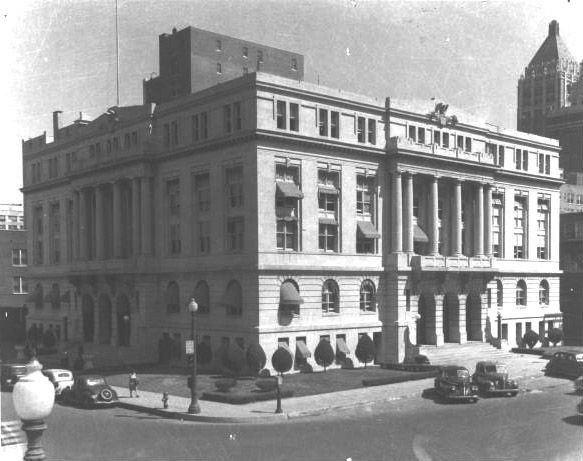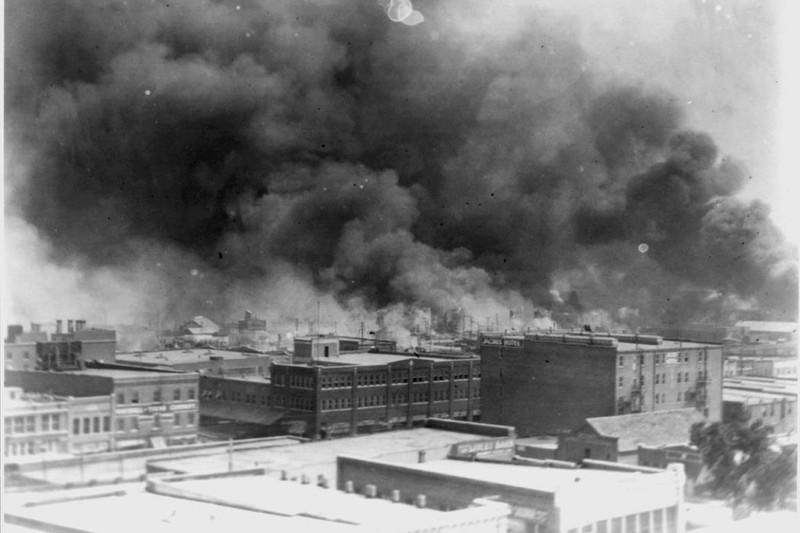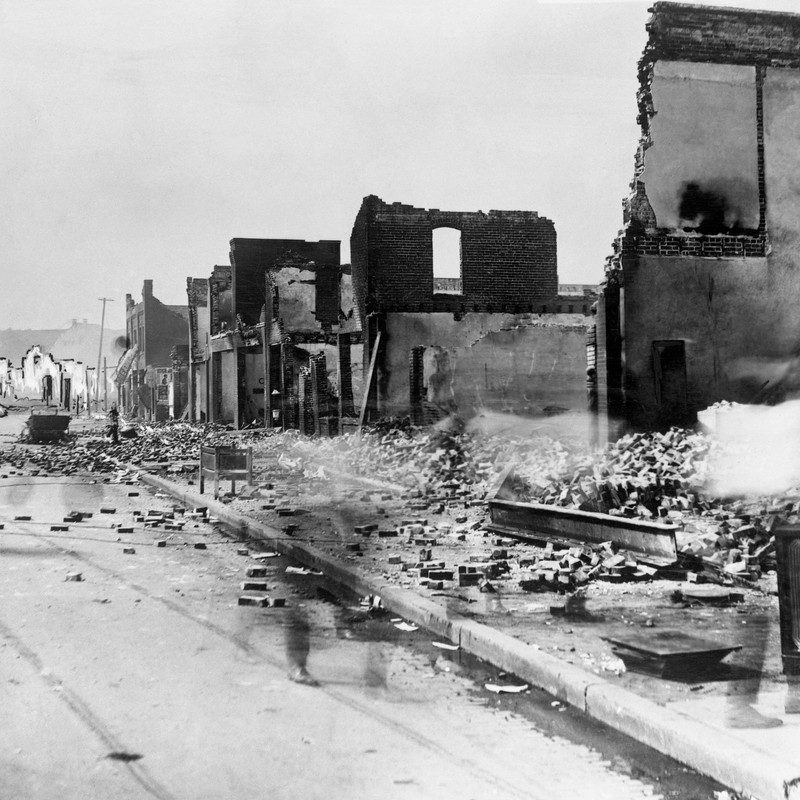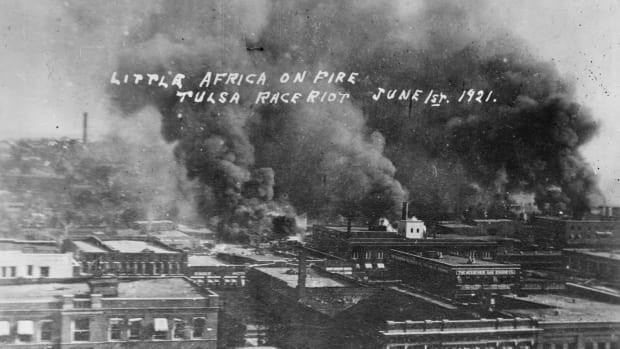Tulsa County Courthouse
Introduction
Text-to-speech Audio
Images
Tulsa County Courthouse

Destruction of Black Wall Street

Aftermath of Massacre


Backstory and Context
Text-to-speech Audio
In 1906, O.W Gurley purchased 40 acres of land in Oklahoma, which was "only to be sold to colored," and named it Greenwood District. With the intention of developing a community where Black people could succeed, he built a boarding house in Greenwood for them to stay in while they began to generate their wealth. Soon, Black people began to flock to Greenwood looking for opportunities for wealth and success. Gurley, committed to the development of the community, loaned out money to those that wanted to start businesses. Amidst the peak of Ku Klux Klan activity in Oklahoma and near the Red Summer of 1919, Greenwood truly began to prosper, attracting attention from folks throughout the South. It was during this time when Booker T Washington coined the nickname for the Greenwood District, “Negro Wall Street,” now commonly known as “Black Wall Street.” Eventually, Greenwood became truly self-reliant, gaining financial independence starkly different from that of the average Black community in America at the time. Even those who worked outside Greenwood as janitors or any lower-level job contributed to the thriving community by taking money from the outside and circulating it within the Greenwood businesses. It is said that “within Greenwood every dollar would change hands 19 times before it left the community.”
The success of the Greenwood District is largely attributed to the variety of businesses that allowed the community to be self-contained. Greenwood was home to numerous hotels, restaurants, doctor/physician offices, law firms, grocery stores, and more. Citizens of Greenwood could stay in their communities without leaving for necessities. Due to this, Greenwood was separated from the surrounding communities, literally and figuratively. When O.W. Gurley bought the land, it bordered railroad tracks that denoted a distinct separation between the outside white communities and Greenwood. Over time, the segregated communities grew even more distant, and as Greenwood prospered, the whites nearby grew enraged. As expected, the success of an all-Black community in the early 1900s was not easily accepted by white people. For years, whites attempted to hinder the growth of Greenwood, culminating in the devastating 1921 Massacre of Black Wall Street.
On May 30th, Dick Rowland entered the elevator of the Drexel Building to go to the only bathroom available for colored people nearby. He worked at a shoeshine parlor down the street and frequently used the bathroom in the Drexel Building. On this particular day, there were not many people out since many businesses were closed for Memorial Day. However, working the elevator in the Drexel Building was Sarah Page, who we can assume knew of Rowland since he frequently used the elevator. What happened next is unclear, but was nonetheless a driving factor in the destruction of Greenwood. A local shop owner heard a woman scream and Rowland run out of the Drexel Building. Without eye-witnesses to the incident, the story was unsurprisingly skewed against Dick Rowland. When Sarah Page was questioned, she did not mention assault, rather noting that Rowland grabbed her hand. A common interpretation today is that Rowland tripped when coming out of the elevator and grabbed Page’s hand for stabilization. Whatever happened, Rowland was brought into the city jail under a lowkey investigation and was set to be released very soon. Calls came in threatening Rowland’s life that forced the police commissioner to move Rowland to the county courthouse for his protection. This proved ineffective as the Tulsa Tribune later reported that Rowland assaulted Sarah Page, leading angry white mobs to form outside the county courthouse.
Residents of Greenwood knew that they had to protect Rowland, however, there was dissent on how. Gurley and some of the wealthier men argued that they should not get involved with the white mobs and should wait until Rowland was released, but many disagreed. Many World War 1 veterans immediately took arms and rallied more to head to the jail and protect Rowland from being lynched. Over 50 men made their way to the courthouse where they were met with mass amounts of enraged whites. Seeing the armed group of Black men, many in the white mobs went back to their homes to retrieve their guns. This was where the 1921 Massacre of Black Wall Street began. The Greenwood men that came to defend Rowland were greatly outnumbered and the white mob began to descend upon Greenwood. Without going into great detail, the white people destroyed Greenwood. The one of a kind community that was 15 years in the making was gone within 2 days. Houses, offices, restaurants, beauty parlors burnt to the ground and taken away from those that worked so hard for it all. There were even reports of aircrafts dropping bombs onto buildings. Amidst it all, the police and fire departments did nearly nothing, allowing the white people to continue murdering, looting, and burning. Martial Law was eventually declared and the National Guard brought in, but it was too late. Over 1200 homes were destroyed and 35 blocks burnt down. The everlasting, self-sustaining community that O.W. Gurley and J.B. Stradford once envisioned was gone.
Casualties of this devastating event are still unclear today. It was initially reported that only white people died, but as time progressed and research went into this, the number of casualties was revealed to be closer to 300+ Blacks dead and a minimal amount of white people dead. It is widely believed today that many bodies are buried throughout the Greenwood district, as there are only 2 official graves pertaining to the event. Following the 2 days of destruction, residents of Greenwood were basically left to their own, with tents from the Red Cross to act as temporary housing. Many of the prior leaders of the Greenwood community were forced to flee, in an attempt to avoid being charged as an instigator of the “riot,” which had been dealt to both O.W. Gurley and J.B. Stradford. Greenwood was eventually on a path to be rebuilt, with support from the Red Cross and the NAACP, but was hit with many legal restrictions, arising from the white communities nearby.
Today the effect of the 1921 Massacre of Black Wall Street and similar happenings in that time period does not go unnoticed. White attack on the success and wealth of Black people is a prime contributor to the low average income of Black families today. However, events like this are rarely talked about in history classes, which is a major problem that needs to be fixed. For America to move forward, we must know and understand our past and its implications to our present society.
Sources
“The Devastation of Black Wall Street | JSTOR Daily.” JSTOR Daily, 5 July 2017, daily.jstor.org/the-devastation-of-Black-wall-street/. Accessed 22 Nov. 2020.
Clark, Alexis. “Tulsa’s ‘Black Wall Street’ Flourished as a Self-Contained Hub in Early 1900s.” HISTORY, 4 Sept. 2019, www.history.com/news/Black-wall-street-tulsa-race-massacre. Accessed 22 Nov. 2020.
Krehbiel, Randy. “Tulsa Race Massacre: This Is What Happened in Tulsa in 1921.” Tulsa World, 31 May 2020, tulsaworld.com/tulsa-race-massacre-after-his-arrest-dick-rowlands-life-threatened-while-jailed/article_65c36b30-3826-582f-9ba9-289301861e0e.html. Accessed 22 Nov. 2020.
Greenwood Cultural Center. “Greenwood Cultural Center.” Greenwood Cultural Center, 2012, greenwoodculturalcenter.com/Black-wall-street. Accessed 22 Nov. 2020.
Vox. “The Massacre of Tulsa’s ‘Black Wall Street.’” YouTube, 27 Feb. 2019, www.youtube.com/watch?v=x-ItsPBTFO0&fbclid=IwAR2GBrHL0f6IONAYAQPRHAxow3V-3yhR3LSLGw7V5hA5hGSklNTn-w_LhCk. Accessed 22 Nov. 2020.
https://www.google.com/url?sa=i&url=https%3A%2F%2Fwww.pinterest.com%2Fpin%2F193443746463905006%2F&psig=AOvVaw1V5hJSOpPcf4f_nEvzHwRB&ust=1606165278027000&source=images&cd=vfe&ved=0CAIQjRxqFwoTCJil3YmGl-0CFQAAAAAdAAAAABAD
https://www.google.com/url?sa=i&url=https%3A%2F%2Fdaily.jstor.org%2Fthe-devastation-of-black-wall-street%2F&psig=AOvVaw2p9YVRQNoE-hbMvNoPresK&ust=1606165316491000&source=images&cd=vfe&ved=0CAIQjRxqFwoTCLDWlJuGl-0CFQAAAAAdAAAAABAO
https://www.google.com/url?sa=i&url=https%3A%2F%2Fwww.nytimes.com%2F2020%2F06%2F19%2Fopinion%2Ftulsa-race-riot-massacre-graves.html&psig=AOvVaw2p9YVRQNoE-hbMvNoPresK&ust=1606165316491000&source=images&cd=vfe&ved=0CAIQjRxqFwoTCLDWlJuGl-0CFQAAAAAdAAAAABAr
https://www.google.com/url?sa=i&url=https%3A%2F%2Fwww.history.com%2Fnews%2Fblack-wall-street-tulsa-race-massacre&psig=AOvVaw2p9YVRQNoE-hbMvNoPresK&ust=1606165316491000&source=images&cd=vfe&ved=0CAIQjRxqFwoTCLDWlJuGl-0CFQAAAAAdAAAAABAx
